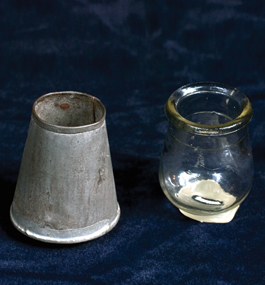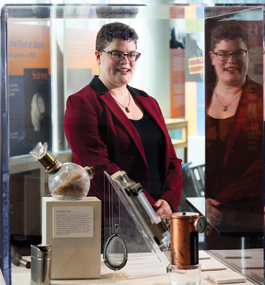First, Do No Harm?
A new book on health-care artifacts examines medicine’s power to heal — and hurt.

Courtesy Wilson's Creek National Battlefield, Missouri
SANGUINE: Bleeding cups used during the 1860s.
by Laura Gardner, P’12
In the late 18th century in America, the job of chimney sweep fell largely to free or enslaved Black men young enough to climb up inside a flue. In addition to the occupational hazard of lung disease, these men often developed “soot wart,” a deadly cancer of the scrotum.
Physicians in Civil War field hospitals relied on the centuries-long tradition of cupping: placing metal or glass cups over a patient’s unbroken or bleeding skin, then creating a vacuum seal to draw out “toxins.” Though cupping might distract the patient from what actually ailed him, the technique (still practiced today in some alternative-medicine circles) had nothing to do with healing.
In the 1930s, the Tuskegee Institute Syphilis Study began its observation of Black men who suffered from syphilis — without ever treating them, though treatment was available. The men, who didn’t know they had syphilis, never consented to participate. In 1974, two years after the study was finally closed down, the U.S. Congress passed the National Research Act, which mandated review boards and a code of ethics for federally funded studies.
Alongside blockbuster triumphs, the history of health care is filled with similar stories of neglect and abuse. In a fascinating book, “Exploring American Healthcare Through 50 Historic Treasures” (to be published by Rowman & Littlefield in December), author Tegan Kehoe ’10 takes the measure of medicine’s good, bad and ugly past by examining an array of medical artifacts, each encapsulating a deeper story about the racial, gender, cultural and political realities of its day.
For example, there’s the corset constructed from flexible stays, instead of stays made from organ-squeezing whalebone or steel. Its proponents claimed, in a conflation of medical science and gender norms, that this corset would enhance not only a woman’s beauty but her health. “Medical views of women’s bodies created arguments both for and against the corset,” Kehoe writes in her book. “Some doctors, especially women, argued that if women were weak, corsets were partly to blame. Others argued that as the ‘weaker sex,’ women needed a corset’s support.”
Another medical device highlighted in the book, the Budin craniometer, was used to both racially categorize people on the basis of their skull size and rationalize all kinds of racist behaviors, including slavery. Other artifacts, drawn from the collections of medical museums around the U.S., include a wax model of a chimney sweep’s cancerous scrotum, a glass slide of tissue samples with bubonic plague from a 1920 outbreak, a 1960 Enovid birth-control pill pack and an ambulance salvaged from the World Trade Center site after the 9/11 attack.
Kehoe studied history and creative writing at Brandeis, and earned a master’s in history and museum studies at Tufts, studying the social history of collective identities such as race, class, gender and disability — “all the ways that people categorize one another,” she says.
After grad school, she landed a job as exhibit and education specialist at the Paul S. Russell, MD, Museum of Medical History and Innovation at Boston’s Massachusetts General Hospital. When Kehoe discovered a publisher was interested in books that explored historical topics through museum artifacts, she jumped at the chance to link her interests in medical and social history.
One of MGH’s landmark advances, the first successful public demonstration of surgical anesthesia, is among the events the book covers. In 1846, doctors crowded into the hospital’s surgical amphitheater to watch as a patient inhaled ether for a few minutes. He then “drifted off,” writes Kehoe, “and when he awoke, recalled only a dull scraping — the surgeon making a 3-inch incision in his neck. The drug had worked, and the patient was in fine condition.”

Mike Lovett
Tegan Kehoe ’10
page 2 of 2
As Kehoe notes, the history of American medicine is neither “a tidy story about progress and the march of science,” nor “a gruesome spectacle, filled with the macabre and not for the faint of heart.” Both narratives have some merit, she contends, and both have flaws.
“Behind the ghastly reality of surgeons operating without cleaning their bone saws between patients, there were people doing their best with what they knew,” Kehoe says. “The same is true for patients buying nostrums, and the same is true of doctors and public health officials debating the safety of raw milk in the 1880s or of DDT in the 1960s. Many people were doing the best they could with the information they had, which is great when their goal was to get healthy, or stay healthy, or manage a chronic condition, or help someone else get healthy. But what about when the goal is to oppress people?”
Examining the timeline of American health care from the 1790s to the 21st century as a social historian, Kehoe discovered plenty of narratives of stigmatization and exploitation, usually of impoverished people and people of color.
Consider cocaine, for instance. Although the coca plant had been used for centuries in some cultures, its active ingredient, cocaine, wasn’t isolated until the 1860s. Widely used as a stimulant, local anesthetic, stamina builder and cure for addiction, cocaine was available over the counter. “A mixture of red wine and cocaine was extremely popular,” says Kehoe. “It was called Vin Mariani, and everyone from Thomas Edison to Pope Leo XIII endorsed it.”
But by the early 20th century, cocaine’s addictive qualities were better understood, and its use was being driven underground. Now one’s view of cocaine addiction was dependent upon the user’s race and socioeconomic status. “Addiction came to be defined as a medical matter for the privileged in society, and a matter of degeneracy for everyone else,” Kehoe says.
Today, we take the innovations the book describes — pasteurized milk; preemie incubators; insulin; Naloxone, for reversing opioid overdoses — for granted. Advances like these have saved many lives.
Nevertheless, Kehoe says, working on the book during the coronavirus pandemic, at a time when so many around the world have such poor access to adequate health care, gave her a chilling recognition of how history rhymes, even as progress marches on.
